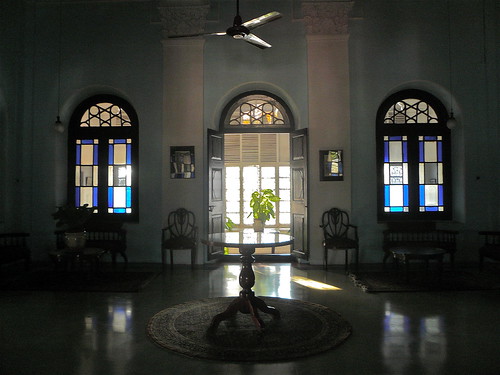
What does our aesthetic say about who we are? Based on the artifacts, what will future historians conclude about our values and our way of being in the world?
Real art puts the unsaid, and the unconscious, into objects. We interact with it to understand reality better. Meanwhile, the artistic choices of the rest of us are loaded with unconscious stuff. It can get awkward.
When it comes to ashtanga aesthetics now, here’s my question. What in the imagery we are making is actually beautiful? I’m talking beauty that opens up reality, and opens the heart. Not just candy that catches your eye, or summons the response “I want that.”
Internet ashtanga 2013 delivers an emphasis on image, with an aestheticization of our collective rippling abdominals and flexible hips. (Nice intermediate series, everyone. Really. This stuff is HARD and you have done the work.) And there is a bizarre new icon in the mix: the disciplined-adventurous calorie-counting white woman, wearing small amounts of clothing, doing a massive yoga posture, outside, in India, in an urban setting. At the margins of the frame is a person with brown skin, ragged clothing, and look of bewilderment or offense. The colors are saturated; it’s dusty; the natives are tired; and the bendy vagabonds are very, very far from home.
Nailed it. Colonialism has an aesthetic signature, and this is it.
This is the style produced by adventurers who land in the global south. It’s been around since Hemingway, though there are whiffs of it as early as the journals of Cristóbal Colón. Its tropes are heat exhaustion and the hard work of plunder, cheap exotic raw materials, distance from “civilization,” precious quirky natives that can be pushed around, the sex appeal of sweat and vagabonding.
Cue up Bonny Prince Billy’s song Southside of the World. Latent themes include cultural difference, alienation, appropriation, oppression and power. The exotic commodities on display might be linens, fruit, tea, wood, handcrafts. Yoga postures.
This aesthetic is beautiful.
I spent my 20s seeking it out in alternating cycles of rage and revelry. I lived for years in Central America, traveled the Caribbean, read magical realism and obsessed about the Cold War and the Nicaraguan Revolution all the way to graduate school. This aesthetic is sultry and dramatic, dense with religion, subversion and intrigue. Have you been to an actual banana republic? How about Mysore’s Green Hotel, Oak Alley on the Mississipi, the downtowns of Latin American capitals? See also: Graham Greene and Heart of Darkness on the right hand, and Wide Sargasso Sea and The Golden Notebook on the left. Gorgeous outtakes are the German colonialist section of Pynchon’s V, or the French outpost scene in the long version of Apocalypse Now.
So, I like this stuff. There are ways to work with the culturally hard-wired aesthetic of colonialism without reproducing the oppression and plunder that motivated Colón. There are ways to appreciate it without that taking us even deeper down the rabbit hole of entitled white attention-getting leisure experience.
But not if we’re aesthetically immature. Not if we’re just assembling elements our subconscious tells us “go together” and jumping in the frame with them in a bid for attention. Again, our everyday aesthetic choices are tricky because they express our unconscious stuff, whereas real art (made by an insightful few – thank you, visionaries) is non-derivative, not so needy, and very much awake.
So what’s unconscious in our Mysore porn? I don’t know. But something is going on here, and some questions may tease it out. What is the attitude our images have toward space? Whose space is it? Is there communication among those inside the frame; and who is getting pushed outside the frame? Or pushed inside the frame? Is there an awareness of how commodification works? Can we empathize with the people and culture on display? Are the people smiling? What got photoshopped?
I have no moral argument to make here. Orientalism was written the year I was born and I’m over it. Have fun on yoga vacation, everyone. Play, dance, love. Do some secret service. Nobody owns yoga; nobody owns culture; modern comfort with the body and social decorum are good; and it’s nice that globalization translates these values to most corners of the planet. That said, if someone wanted to over-think this, the line of critique would be something about appropriation, whiteness, first world feminism, easy exchange rates on the Rupee, family money, easy credit, and deep infrastructural privilege. Something about people hanging out for 12 weeks in Mysore and just not getting it on a human level. Whatever.
For me, it’s not an ethical but an aesthetic thing. On a purely personal level that does not prevent me from adoring the majority of people who have other preferences, I find commercial yoga tacky. You already know my idiosyncrasies. It’s not lululemon; it’s me.
Until there is the face of a marginalized, wide-eyed woman in the frame. Until the imagery itself is an act staking an exclusive claim to the meaning-space there. Then all of a sudden there’s this juxtaposition of (1) the marginal characters’ subjectivities, together with (2) the self-objectifying, attention-monopolizing poser at the center in (3) an environment that the poser doesn’t seem to want to understand.
That juxtaposition brings up ethical questions for me, about our self-centerdness as asana practitioners and travelers. The aesthetic itself raises up my ethical bottom line, which has to do with giving back the fruits of our practice to the world, to god, giving back anywhere but to the attention-seeking self.
There is no judging matters of taste. But is it in our good taste to fetishize hardcore historical inequality? When matters of the heart come this close to the surface, aesthetics and ethics intertwine.

26 Comments